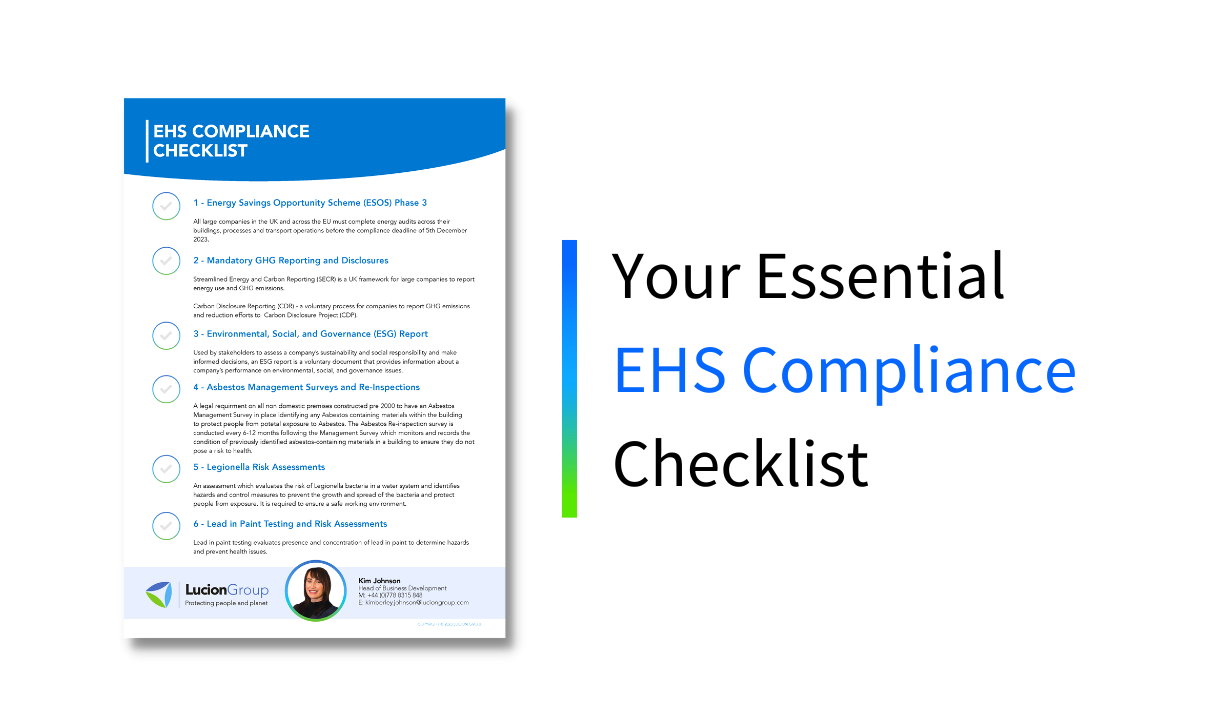12 Things To Put On Your 2023 Compliance Checklist
23 January 2023
At Lucion Group, we specialise in environmental risk management and inspection services, with a focus on protecting people and the planet. Our mission is to prevent occupational and environmental risks and protect individuals whenever possible. In order to achieve our mission, we understand our important role in knowledge sharing, helping Compliance and Facilities Managers to be successful in their roles through effective risk management.
Kim Johnson, Lucion Group’s Head of Business Development at this year’s event, shares our 2023 EHS compliance checklist.
Environmental, Health and Safety (EHS) Compliance refers to the adherence to laws, regulations, and other standards that are related to the protection of the environment, public health, and the safety of workers and the general public.
EHS compliance involves implementing measures to prevent or minimise the negative impact of a company's operations on the environment and on the health and safety of its employees, as well as of the surrounding community. This can include things like properly managing and disposing of hazardous materials, controlling emissions and discharges, implementing safety protocols in the workplace, and following regulations related to the handling and storage of chemicals, among others.
Ensuring EHS compliance is vital for protecting the environment and public health, and it is also essential for minimising the risk of legal and financial consequences for companies that fail to meet regulatory standards.
Our teams across the Lucion Group have put together their top 12 compliance checklist for 2023. Whilst this list isn’t exhaustive, it makes for a great foundation for Compliance, Facilities and Health and Safety managers to get started on their journey to compliance. You can download a summary 2-page PDF of the below checklist here: EHS Compliance Checklist.
12-Step Compliance Checklist
1. ESOS Phase 3 – The Energy Savings Opportunity Scheme (ESOS) and its EU sibling the Energy Efficiency Directive (EED) are back in 2023 with all Large Companies needing to demonstrate compliance on or before the Compliance Date of 5th December 2023.
Under both schemes, companies with over 250 employees, or with a combined turnover of £44m (or €50m) and balance sheet total of £38m (or €43m) must undertake Energy Audits to identify opportunities to reduce energy demand across its buildings, processes and transport operations.
Delta-Simons Sustainability team has registered ESOS Lead Assessors who can support you with developing a Compliance Plan, and scheduling the works well in advance of the upcoming deadline. (email: Rob.Molyneux@deltasimons.com).
Through our partners in the Inogen Alliance, we can help to establish a plan for compliance across all EU Member States.
You can read our latest Carbon Energy Reporting Case Study from our company, Delta-Simons, here: Global Technology Retailer Carbon & Energy Reporting.
2. Mandatory GHG Reporting and Disclosures - Streamlined Energy and Carbon Reporting (SECR) is a reporting framework introduced in the UK in April 2019. SECR requires certain large companies and organisations to disclose information about their energy use and Green House Gas (GHG) emissions.
Under SECR, qualifying organisations must report their energy consumption and associated greenhouse gas emissions on an annual basis. The aim of the framework is to increase transparency around energy use and carbon emissions and to encourage companies to take steps to improve energy efficiency and reduce their carbon footprint. SECR applies to large UK companies and organisations that are required to report under the Companies Act 2006, as well as public sector bodies with at least 250 employees. It does not apply to small and medium-sized enterprises (SMEs).
Carbon Disclosure Reporting (CDR) - Whilst not mandatory, CDR is a process through which companies and organisations report on their greenhouse gas (GHG) emissions and their efforts to reduce them. The Carbon Disclosure Project (CDP) is an international non-profit organisation that runs a global disclosure system for companies to report on their GHG emissions, water usage, and forestry-related activities. CDP's goal is to provide investors, companies, cities, states, and regions with the information they need to make informed decisions to reduce GHG emissions and mitigate climate change.
Through the CDP disclosure process, companies and organisations can report on their GHG emissions, as well as their efforts to reduce them, such as through energy efficiency measures, renewable energy use, and other sustainability initiatives. The information disclosed through CDP is used by investors, procurement teams, and policymakers to better understand a company's environmental impact and risk, and to make more informed investment and purchasing decisions. CDP also uses the information disclosed through its platform to compile rankings and scores of companies based on their GHG emissions and efforts to reduce them.
You can read our latest Carbon Footprint Report and Reduction Pathways Case Study from our company, Delta-Simons, here: PPN06/21 Compliance For Shaw Trust.
3. Environmental, Social, and Governance (ESG) Report - An ESG report is a document that provides information about a company's performance in relation to environmental, social, and governance (ESG) issues. ESG reporting is a way for companies to disclose information about their efforts to address a range of issues that are important to stakeholders, including investors, employees, customers, and the broader community. These issues can include things like a company's carbon emissions and energy use, water consumption, employee diversity and inclusion, supply chain management, and corporate governance practices.
ESG reports can be used by investors and other stakeholders to assess the sustainability and social responsibility of a company, and to make more informed decisions about whether to invest in or do business with the company. ESG reports may also be used by companies themselves as a way to track their progress in addressing these issues and to identify areas where they can improve. ESG reporting is becoming increasingly common, and many companies now publish annual ESG reports or include ESG information in their regular financial reporting.
Whilst ESG reporting is not mandatory it is an effective way of building a reputable business and attracting talent into an organisation.
You can read our latest ESG Appraisal Case Study from our company, Delta-Simons, here: Clearbell Capital Portfolio.
4. Asbestos Management - A duty holder is responsible for the asbestos management onsite, they must ensure that any non-domestic premises constructed prior to the year 2000 have an up-to-date Asbestos Management Survey and an Asbestos Management Plan in place to accurately identify any asbestos-containing materials present onsite to prevent people from potential exposure. Following on from an Asbestos Management survey an asbestos re-inspection survey (also referred to as an annual asbestos re-inspection survey) would then be required if ACM’s are identified on site to allow the duty holder to monitor and record the condition of any previously identified asbestos products within a building. As specified in step 6 of the INDG223 - Managing Asbestos is Buildings (A Brief Guide), the HSE recommends that re-inspection of ACMs should be undertaken every 6-12 months, depending on the condition of the ACM.
Asbestos is a naturally occurring mineral that was used extensively in building materials, insulation, and other products prior to the late 1970s, when the health risks associated with exposure to asbestos became widely known. Asbestos can cause serious respiratory diseases, including mesothelioma, a rare and aggressive form of cancer, if inhaled.
Asbestos Re-inspections are typically conducted by a trained and certified asbestos inspector, who will look for materials that may contain asbestos and assess their condition. If ACMs are found and are in good condition, they may not pose a risk to the people who come into contact with them. However, if the materials are damaged, deteriorating, or are likely to be disturbed during normal use or renovation activities, they may need to be repaired, removed, or sealed to prevent the release of asbestos fibres. Re-inspections are typically required at regular intervals, as specified by local or national regulations, to ensure that any ACMs in the property are properly managed and do not pose a risk to people's health.
If you are the duty holder, you are required to manage your asbestos risks in line with the Control of Asbestos Regulations (CAR) 2012. Effectively managing your asbestos risks is imperative to protecting your building occupants, environment, and organisation from the risks of asbestos. Regular asbestos re-inspection surveys will ensure you remain compliant.
You can read one of our Asbestos Re-Inspection Case Studies from our company, Lucion Services, here: NHS Foundation Trust Yorkshire.
5. Legionella Risk Assessments - A Legionella risk assessment is a process of evaluating the risk of Legionella bacteria in any particular water system, such as a domestic hot and cold system, cooling tower, process water system and many more. Legionella species are naturally found in the environmental water sources such as reservoirs, lakes and rivers but the bacteria can also multiply under the suitable conditions in man-made water systems. Legionella bacteria is more prone to be found and multiply in water systems with recirculation, stored water and poor temperatures if the system is not under control. Inhaling water droplets that contain the bacteria can cause a severe type of pneumonia called Legionnaires disease, which can be life-threatening, particularly for people who are older, have compromised immune systems, or have underlying health conditions.
A Legionella risk assessment involves identifying; the source of water to the system and the potential for contamination, understanding the water system and its purpose, the condition of the water system and the risk to influence bacterial growth, the potential for the water system to create water droplets/aerosol release and the exposure to any individual. The assessment also involves evaluating the control measures in place to prevent or minimise the risk of contamination and exposure to the bacteria, such as water treatment and planned preventative maintenance programs. The ultimate goal of a Legionella risk Assessment is to identify any potential hazards and implement appropriate control measures to prevent the growth and spread of the bacteria, and to protect the health and safety of people who may be exposed to it.
The Health and Safety at Work Act 1974 (HSWA) requires that the duty holder (employer or landlord) ensures a safe working environment. The Management of Health and Safety at Work Regulations 1999 (MHSWR) provides a broad framework for controlling health and safety at work but more specifically, The Control of Substances Hazardous to Health Regulations 2002 (COSHH) provide specific guidance on how to assess, mitigate, and control the risk of exposure to hazardous substances and biological agents including Legionella bacteria.
6. Lead in Paint Testing and Risk Assessments - Lead in paint testing is a process of evaluating the presence and concentration of lead in paint or other coatings on surfaces in a home, building, or other assets. Lead is a highly toxic metal that can cause serious health problems, and is particularly hazardous for children and pregnant women. Lead was added to internal and external paints, primers and other coatings in the past as it offered useful properties including durability, corrosion resistance, accelerated drying, and even decorative colours. Its use within both domestic and non-domestic buildings, and indeed upon plant and equipment, was heaviest up until the 1960s, although its use continued in some forms up until the 1990s.
Its use was phased out and finally banned in response to the recognition of severe health effects including lead poisoning, central nervous system toxicity, and kidney disease associated with long-term and excessive lead exposures. Lead paint is only harmful when it becomes degraded, chipped or is being removed without the proper precautionary measures in place, allowing lead dust to be inhaled.
Lead can be found in many buildings, structures, and upon plant and equipment. The Control of Lead at Work Regulations (CLAW) 2002 place a duty of care on employers and building managers/owners to assess risks, prevent or control exposure to lead, and put other measures in place to protect people as far as reasonably practicable.
For all refurbishment, development and demolition projects, there is a legal requirement for lead paint to be identified so that risks can be assessed and managed: the best way to do this is to undertake paint testing or surveying.
Lead in paint testing involves collecting a sample of paint or other coatings from the surface and analysing it in a laboratory to determine the presence and concentration of lead. Alternatively, paint can be tested non-destructively using X-ray Fluorescence Spectrometry (XRF), which is a handheld device that provides results at the time of testing. Testing for lead in paint is important because it can help identify hazards that may need to be addressed, such as removing or encapsulating paint that contains high levels of lead. Lead in paint testing, and the provision of interpretive reports and recommended actions, are typically done by trained and certified professionals who follow proper safety protocols to minimise the risk of exposure to the metal.
You can read our latest Lead In Paint Case Study from our company, Lucion Services, here: Sewell Construction Ltd - Rutland Mills Lead In Paint.
7. Safe Systems of Work (SSOW) / Safety Management Systems (SMS) Review - SSOW are procedures, policies, and guidelines that are put in place to ensure the safety and health of workers while they are carrying out their job duties. They are designed to identify and manage the risks associated with work activities and to minimise the likelihood of accidents, injuries, and other incidents that could cause harm to workers. Safe systems of work can include things like hazard assessments, risk assessments, standard operating procedures, training programs, and emergency procedures.
SSOW are an important aspect of occupational health and safety management, and they are typically implemented in a variety of industries to protect the health and well-being of workers. They can be specific to a particular job, task, or process, or they may be more general in nature and apply to a wider range of activities. Effective safe systems of work require the participation and commitment of both employers and employees, and they should be regularly reviewed and updated to ensure that they continue to effectively address the risks associated with work activities.
SMS provides a systematic approach to managing safety on site, implementing policies and procedures and improving staff behaviour and attitudes. SMS focus on a Plan-Do-Check-Act cycle to encourage continuous improvement of a company’s safety culture.
The implementation of a positive safety management system has huge benefits for businesses beyond the obvious legal implications of not having an SMS at all. Lower accident-related costs, reduction in downtime and improved health and safety culture are just some of the benefits customers can expect once an effective SMS is implemented and team members are correctly onboarded.
Under the Health and Safety at Work act 1974, regulation 3, it is a requirement that the duty holder takes proactive steps to control the risks in the workplace.
8. Fire Safety Audit - A fire safety audit is a systematic review of a building, facility, or system to assess its compliance with fire safety regulations and standards, and to identify any potential fire hazards or risks. The goal of a fire safety audit is to ensure that a property is designed, constructed, and maintained in a way that minimises the risk of fire and maximises the safety of the occupants and the surrounding community.
Fire safety audits typically involve a thorough inspection of the property, including the building structure, fire protection systems, and other elements that are relevant to fire safety. The audit may also include a review of the property's fire safety plan and other relevant documentation, such as maintenance and testing records for fire protection systems. The auditor may make recommendations for improvements or corrective actions to address any deficiencies or areas of concern that are identified during the audit. Fire safety audits are typically conducted by trained and certified professionals who have expertise in fire safety and building codes.
Employers, building owners, duty holders and anyone who is responsible for the safety and well-being of occupants within any commercial building must abide by The Regulatory Reform (Fire Safety) Order 2005 to ensure the safety of employees and visitors.
9. Display Screen Equipment (DSE) Assessments - DSE assessments are evaluations of the workstation setup and conditions for employees who use display screen equipment (DSE) as part of their job duties. DSE includes any equipment that has a screen, such as a computer monitor, laptop, or smartphone, that is used to display information or interact with software.
DSE assessments are typically conducted to review the ergonomic design and functionality of the workstation, as well as the overall comfort and well-being of the employee who uses it. The goal of a DSE assessment is to identify any potential hazards or risk factors that may contribute to musculoskeletal disorders (MSDs) or other health problems associated with prolonged DSE use.
During a DSE assessment, the workstation setup, including the position of the equipment, lighting, and other environmental factors, is inspected and evaluated. The employee's posture and working habits may also be observed and analysed. The assessment may include recommendations for improvements or corrective actions to address any issues that are identified. DSE assessments are typically conducted by trained and certified professionals who have expertise in ergonomics and occupational health and safety.
You can read our latest Ergonomics Case Study from our company, Delta-Simons, here: Global Tech Ergonomics Support.
10. Annual Training Gap Analysis Review - A training gap analysis review is a process of evaluating the training needs and requirements of an organisation or individual, and comparing them to the current training and development activities that are in place. The goal of a training gap analysis review is to identify any gaps or deficiencies in training that may be preventing the organisation or individual from achieving their desired performance levels or goals.
A training gap analysis review typically involves collecting data about the current training programs and activities, as well as the skills, knowledge, and abilities of the employees or individuals being trained. This may include things like job descriptions, performance evaluations, and feedback from employees or managers. The data is then analysed to identify any areas where additional training may be needed to fill gaps in knowledge or skills, or to address changes in business needs or regulations. The results of the review may be used to inform the development of new training programs or to make improvements to existing ones. Training gap analysis reviews are typically conducted by training and development professionals or consultants with expertise in the field.
You can read our latest Health and Safety Training Case Study from our company, Delta-Simons, here: IT Security Online Safety Training.
11. Review of Legal Registers - A review of Legal Registers is a process of evaluating the legal requirements and obligations that apply to an organisation or business, and identifying any gaps or deficiencies in the way that these requirements are being met. A legal register is a document or system that lists all of the legal requirements that apply to an organisation, along with the actions that are required to comply with them.
A review of a legal register typically involves a review of the list of relevant legal requirements to include any new or amended requirements. The review can also incorporate a compliance assessment to review the site or company compliance with relevant legal and other requirements. The review may involve a review of documentation and interviews with employees and other stakeholders to gather additional information about the organisation's compliance status. The goal of the review is to identify any areas where the organisation may be at risk of non-compliance and to make recommendations for improvement. A review of the legal register may be conducted by the organisation itself or by an external consultant or auditor. The results of the review are typically documented in a report that is shared with the organisation and, in some cases, with regulatory authorities.
You can read our latest Legal Registers Case Study from our company, Delta-Simons, here: Global Technology Company Legal Registers.
12. Environment, Health, and Safety (EHS) Compliance Audits - An EHS Compliance Audit is a systematic review of a company's operations, practices, and systems to assess their compliance with environmental, health, and safety laws, regulations, and standards. The goal of an EHS compliance audit is to identify any non-compliances or areas of potential non-compliance and to recommend corrective actions to address them.
EHS compliance audits typically involve a review of the company's policies, procedures, and records related to environmental, health, and safety issues, as well as an on-site inspection of the company's facilities and operations. The audit may also include interviews with company personnel, such as management, supervisors, and employees, to gather information about the company's EHS practices and performance. An EHS compliance audit may be conducted by the company itself, by an external auditor, or by a government agency. The results of the audit, along with any recommendations for improvement, are typically documented in a report that is shared with the company and, in some cases, with regulatory authorities.
The implementation of an effective EHS compliance management system supports organisations in developing a structured and consistent approach to reviewing and mitigating EHS and compliance risks.
How Can Lucion Group Help You To Achieve Compliance?
Our hazardous materials and EHS compliance assessment programs, conducted by our companies throughout the Lucion Group, are designed to align with our client's culture and strategy - creating a prioritised programme to ensure compliance with legal and company requirements.
The Lucion Group’s foundation businesses comprise Lucion Services a market-leading provider of hazardous materials management and Delta-Simons, a multi-disciplinary environmental and health and safety consultancy providing solutions for sustainable development. The Group includes several additional and aligned inspection, assessment and consultancy companies, acquired through our sustainable growth strategy. Our group provide environmental risk management, inspection, assessment and advisory services through our collective group of companies. Through our specialist companies, employing over 600 employees working across 12 sectors, we are uniquely placed to provide holistic compliance and EHS management services.
As a trusted organisation, dedicated to quality, reflected in our QHSE business management systems, which are accredited to ISO 9001, ISO 14001, and ISO 45001, we are the perfect partner for your environmental services. Get in touch with our team today. Click ‘Make and Enquiry’ or call us on 0345 5040 303.
About The Author
Kim Johnson
Head of Business Development at Lucion Services, Kim Johnson, has earned nearly 12 years of experience within the environmental industry. Starting her career as an Asbestos Surveyor/analyst, Kim has gone from strength to strength, earning herself a reputation for taking the pain out of managing hazardous materials for our clients. In her role as Head of Business Development, Kim leads a team of Business Development Managers and Executives, supporting them to effectively support our clients through the complex world of regulations and guidelines in hazardous material management.
Kim Johnson, Head of Business Development
E: kimberley.johnson@lucionservices.com
M: 07788315848
T: 0345 5040 303
Linkedin: Kim Johnson
EHS Compliance: 12 Step Checklist
Download our free 12-step EHS Compliance Checklist and take the first step to safeguard your teams, contractors, and reputation.
No Sign-Up Required
Asbestos Compliance: 6 Step Checklist
Download our free 6-step Asbestos Compliance Checklist and take the first step to safeguard your teams, contractors, and reputation.
No Sign-Up Required
IMPACT Magazine
Industry news delivered by Lucion Group and its subsidiary companies.
Issue 2 May 2023
No sign-up required
Lucion Group Brochure
Lucion Group is a purpose-driven company where we protect people from hazardous environments and protect the environment from the impacts of people.
Find out about our suite of services with our overview services brochure.
No sign-up required
Flood Risk & Climate Resilience - Webinar Slides
Flood Risk & Climate Resilience
Protecting Your Investment
CPD Webinar Presentation Slides
Download Now
 NexGen
NexGen
























